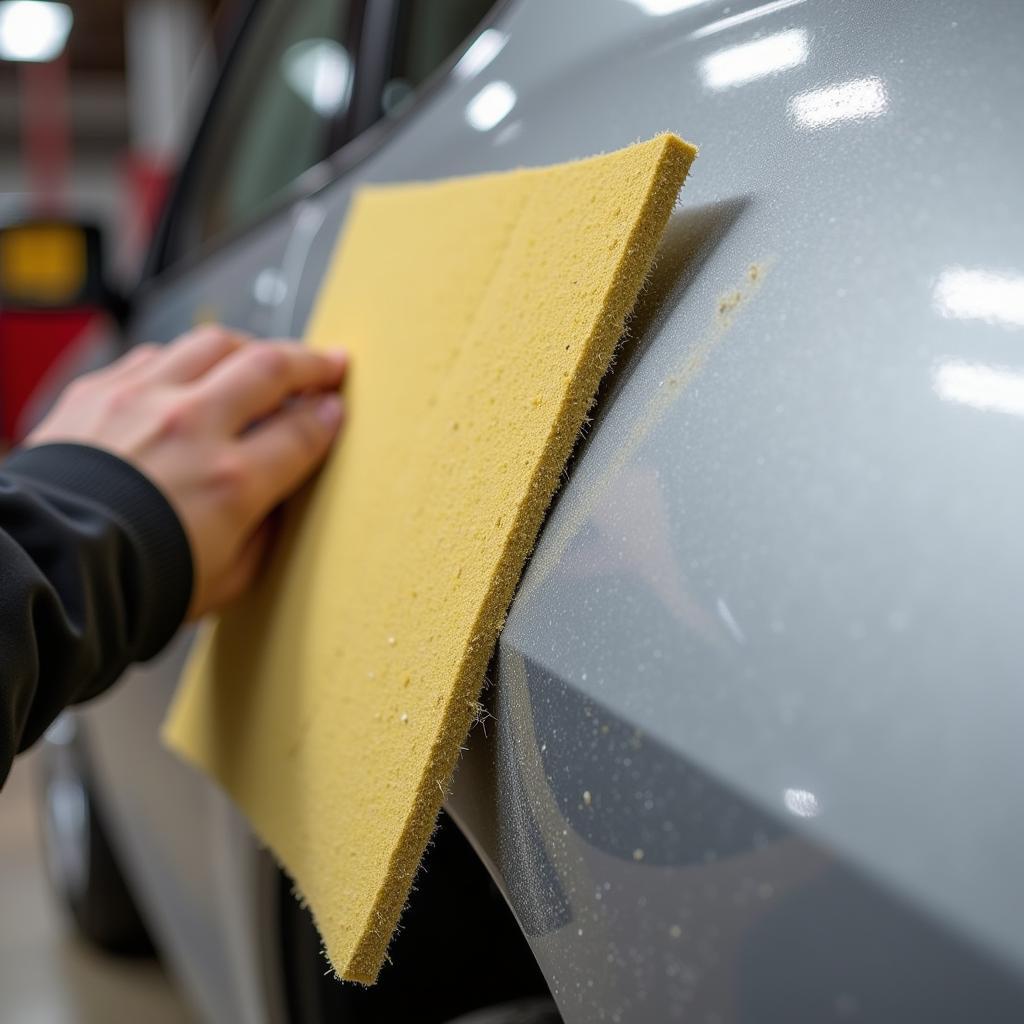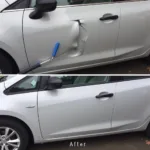When performing a car body patch repair, using 800 grit sandpaper is a common step. However, many DIYers and even some professionals find that 800 grit leaves the paint dull. This article dives deep into the reasons why this happens and offers solutions for achieving a glossy, professional finish after your patch repair.
Understanding the Issue of 800 Grit and Dull Paint
800 grit sandpaper, while effective for smoothing out imperfections after body filler application, creates very fine scratches in the surface. These microscopic scratches, though barely visible to the naked eye, scatter light, resulting in a dull appearance. The problem isn’t the 800 grit itself, but rather stopping the sanding process at that stage. Think of it like polishing a gem – you start with coarse grit to shape it, then gradually move to finer grits for a brilliant shine.
 Sanding a car panel with 800 grit sandpaper
Sanding a car panel with 800 grit sandpaper
Achieving a Glossy Finish After 800 Grit
The key to overcoming dullness after using 800 grit sandpaper is to continue the sanding process with progressively finer grits. This process, known as wet sanding, involves using sandpaper with grits ranging from 1000 to 3000, lubricated with water. Wet sanding minimizes further scratching and refines the surface to a mirror-like finish.
Wet Sanding Techniques for a Flawless Finish
- Start with 1000 grit: After completing the 800 grit sanding, switch to 1000 grit sandpaper. Use a sanding block to ensure even pressure and prevent uneven sanding marks.
- Keep it wet: Constantly lubricate the sandpaper and the panel with water. This helps to flush away debris and keeps the sandpaper from clogging.
- Overlap your strokes: Overlap each sanding stroke by about 50% to ensure consistent smoothing.
- Inspect regularly: Frequently wipe the panel dry to inspect the surface. You’ll gradually see the scratches from the previous grit disappear.
- Progress through the grits: Move up to 1500, 2000, and finally 3000 grit, repeating the process for each grit.
“Many people make the mistake of rushing the sanding process,” explains automotive paint specialist, Michael Davis. “Patience and attention to detail are crucial for achieving a professional finish. Don’t be afraid to spend time on the finer grits – it’s where the magic happens.”
Polishing: The Final Step to a Mirror Shine
After wet sanding, the panel will be smooth but still lack the desired gloss. This is where polishing comes in. Using a polishing compound and a buffer, you can remove any remaining fine scratches and restore the paint to its original shine.
Choosing the Right Polishing Compound
Different polishing compounds are designed for different levels of correction. Start with a medium-cut compound to remove any lingering imperfections, followed by a fine-cut compound to enhance the gloss.
Conclusion: Achieving a Professional Paint Finish After Car Body Patch Repair
Using 800 grit sandpaper during a car body patch repair is a necessary step, but it’s not the final one. By following the steps outlined above, including wet sanding with progressively finer grits and polishing, you can transform a dull surface into a flawless, professional-looking finish. Remember, achieving a high-quality paint job requires patience, attention to detail, and the right techniques. 800 grit leaves paint dull only if you stop there.
FAQ
- Can I skip wet sanding and go straight to polishing?
- What happens if I don’t use enough water during wet sanding?
- Can I use a rotary buffer instead of a dual-action polisher?
- What type of polishing pad should I use?
- How can I tell if I’ve sanded enough?
- What should I do if I sand through the clear coat?
- What are some common mistakes to avoid during the polishing process?
Other Helpful Resources on CarRepairOnline:
- Guide to Car Paint Repair
- Understanding Different Sandpaper Grits
- Choosing the Right Polishing Compound
Need further assistance? Contact us via WhatsApp: +1(641)206-8880, Email: [email protected]. We have a 24/7 customer support team.

